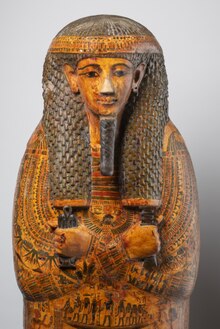| Butehamun | |
|---|---|
 Inner coffin lid of Butehamun, now in Museo Egizio, Turin Inner coffin lid of Butehamun, now in Museo Egizio, Turin | |
| Born | Before 1070 BC In or around Deir el-Medina, Egypt |
| Died | Before 960 BC |
| Occupation | Scribe |
| Years active | c. 11th century BC |
| |||||||||
| Butehamun in hieroglyphs | |||||||||
|---|---|---|---|---|---|---|---|---|---|
| Era: New Kingdom (1550–1069 BC) | |||||||||
Butehamun (fl. 11th century BC) was an Egyptian scribe born and raised in or around Deir el-Medina during the reign of Ramesses XI, the tenth and final pharaoh of the Twentieth Dynasty of Egypt. Butehamun was the son of Thutmose (or Dhutmose) of Deir el-Medina, who was also a scribe, and a member of a family of scribes dating back to the early Twentieth Dynasty.
Under the orders of the High Priests of Amun who maintained the temple complex of Karnak in Thebes, Butehamun was involved in the relocation and reburial of royal mummies from the Valley of the Kings to the Royal Cache (TT320). Throughout his life, Butehamun earned several titles, including "Scribe of the Necropolis", "Opener of the Gates of the Necropolis", "Overseer of Works in the House of Eternity", and "Overseer of the Treasuries of the Kings".
Much of what is known about Butehamun is derived from graffiti and from letters between Butehamun and his father. Though Polish archaeologist Andrzej Niwiński proposed the existence of three scribes, each named Butehamun, connected to the Theban Necropolis, this view is considered discredited. Butehamun died during the Twenty-first Dynasty of Egypt.
Home
Butehamun's residence was located at Medinet Habu, a site near the foot of the Theban Hills on the west bank of the Nile River. Four columns of the adobe remain, bearing inscriptions and images of the god Amun and the pharaoh Amenhotep I, as well as Amenhotep I's mother, the Great Royal Wife Ahmose-Nefertari.
Death and burial
Butehamun died during the Twenty-first Dynasty of Egypt, which lasted from 1077 BC to 943 BC. The whereabouts of Butehamun's mummy are unknown. A set of coffins belonging to Butehamun—an outer coffin, an inner coffin, and a "false lid"—were probably found in the tomb of Nakhte-Min (TT291), a workman from the Eighteenth Dynasty. Butehamun's outer and inner coffins are housed at the Museo Egizio in Turin, Italy.
References
- Ranke 1935, p. 94.
- van Heel, Koenraad Donker (2012). Djekhy & Son: Doing Business in Ancient Egypt. American University in Cairo Press. p. 160. ISBN 978-977-416-477-4.
- Jasnow, Richard; Cooney, Kathlyn M., eds. (2015). Joyful in Thebes: Egyptological Studies in Honor of Betsy M. Bryan. Lockwood Press. p. 420. ISBN 978-1-937040-40-6.
- ^ Wilkinson, Toby (2015). The Nile: Travelling Downriver Through Egypt's Past and Present. Vintage Books. ISBN 978-0804168908.
- @GettyMuseum (6 October 2020). "We know quite a lot about Dhutmose's son, Butehamun, who was also a Scribe of the Necropolis like his father. Butehamun was tasked with relocating the royal mummies in the Valley of the Kings in order to protect them against tomb robbers" (Tweet). Retrieved 30 May 2023 – via Twitter.
- Joann, Fletcher (2016). "Zenith". Immortal Egypt. BBC Two. Retrieved 30 May 2023.
- Taylor 1995, p. 19.
- Davies, Benedict G. (1997). "Two Many Butehamuns? Additional Observations on Their Identity". Studien zur Altägyptischen Kultur. 24: 49–68. Retrieved 30 May 2023.
- Thijs, Ad (2020). "Butehamun and the God's Wife of Amun Maatkare Mutemhat: Two Problematic Burials". Zeitschrift für Ägyptische Sprache und Altertumskunde. 147 (1): 92–105. doi:10.1515/zaes-2020-0028. Retrieved 30 May 2023.
In 1984 A. Niwiński published an article in which he postulated the existence of no less than three scribes called Butehamun. Although his hypothesis was very soon afterwards falsified, the problems with the funeral equipment of Butehamun which led him to his remarkable theory have never been adequately dealt with.
- ^ McDowell, A.G. (2002). Village Life in Ancient Egypt: Laundry Lists and Love Songs. Oxford University Press. p. 73. ISBN 0-19-814998-0.
- Taylor 1995, p. 47.
- ^ Radner, Karen; Moeller, Nadine; Potts, D. T., eds. (2023). The Oxford History of the Ancient Near East: Volume IV: The Age of Assyria. Oxford University Press. p. 37. ISBN 978-0-19-068763-2.
- ^ "Outer coffin of Butehamon". Museo Egizio. Retrieved 1 June 2023.
- "Inner coffin of Butehamon". Museo Egizio. Retrieved 1 June 2023.
Bibliography
- Ranke, Hermann (1935). Die Ägyptischen Personennamen, Bd. 1: Verzeichnis der Namen (PDF). Glückstadt: J.J. Augustin. Retrieved 18 November 2023.
- Taylor, John H. (1995). Unwrapping a Mummy: The Life, Death, and Embalming of Horemkenesi. University of Texas Press. ISBN 0-292-78141-5.